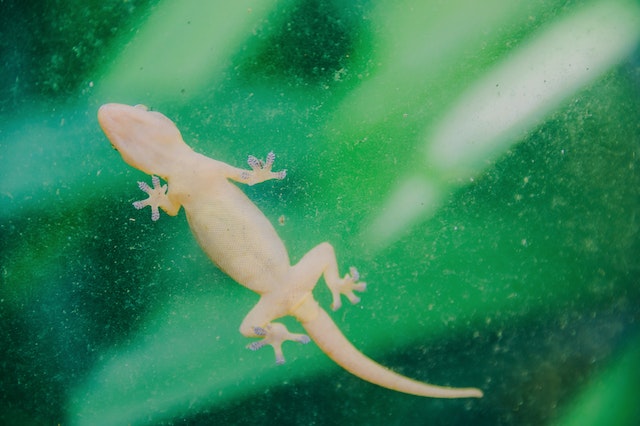
How do some animals walk up walls? They do it thanks to either tiny hairs on their feet or sticky pads. Animals that can walk up walls tend to divide into two categories: sticky feet or hairy feet. They all also rely on the Van der Waals force.
Animals that walk up walls have to overcome several problems. The first is obviously gravity. Their attachment to the surface they are climbing must be stronger than the force of gravity. The larger the animal is, the more force it needs to overcome and the stronger its “stickiness” must be. They also have to be able to attach and detach their feet very quickly. Geckos attach and detach their feet 15 times a second when they run up a wall. Their feet need to grip, but also easily release.
The Van der Waals force is the interaction between atoms. All atoms have a positive and negative charge. The protons carry the positive charge and the electrons carry the negative charge. The protons and electrons move all over the place but, sometimes, all of the protons and all of the electrons align to make one side of the atom positive and one side negative. When this happens, the side that is positive will repel another positive atom and attract another negative atom. This attraction and repulsion is called the coulomb force, or electrostatic force. When a lot of these atoms gather at the same time, it is called the Van der Waals force. The Van der Waals force is strong, but not very strong. The attraction and repulsion is easily overcome. An example of this is a microfiber cloth. The fibers in the cloth are 3 to 5 microns in diameter and when the cloth is used to wipe something, all of the atoms in the fibers attract the molecules of dirt due to this Van der Waals force and the dirt is stuck until it is washed off.
Hairy feet are the most common, so let’s look at sticky first. Frogs and some insects use the sticky method. Frogs secrete a mucus onto the pads of their feet. These pads are flexible and can make a flat seal with the surface they are climbing, a tree, for example. The molecules in the mucus stick to the molecules in the tree due to the Van der Waals force. The surface area of the frog’s feet is large enough to hold the frog in place, but the force is easily overcome when the frog wants to move. Houseflies use a similar system. They secrete a sticky substance made from sugar and oil onto their feet. This allows them to stick to any surface and is also why you might be able to see fly footprints on a window. Flies also have claws at the end of their foot, which they can use to twist the foot as they move, breaking the attraction.
Spiders and lizards use the hairy system. Both lizards and spiders have thousands of microscopic hairs on their feet. These hairs are called setae and the end of each hair has about 1,000 flat, pointed surfaces called spatulae. A gecko, for example, has about 14,000 setae on each foot, but each setae has 1,000 spatulae. A spider has about 2,400 setae per foot, with each one having about 1,000 spatulae. The setae and spatulae are made of chitin, which is the same substance the exoskeleton of insects is made of. Each setae is about 100th of a millimeter in diameter. These hairs cover the feet of spiders, lizards, and many other animals that use this method. When spiders and lizards climb a flat surface, the hairs are so small that they slip into tiny cracks and space in the surface of whatever they are climbing. Then the spatulae stick to the surface because of the Van der Waals force. Even glass, which looks perfectly smooth to us, has cracks and ridges that spatulae can stick to. Spiders have claws that detach them, similar to flies. Geckoes walk with a sideways movement of each foot, so they twist it in to grip and then twist it again to break the grip.
The drawback with both of these methods is that the larger the animal is the more sticky mucus, or the more setae and spatulae it will need. Frogs cope by making the surface area of their feet larger, but there is a limit to how big their feet can get and therefore a limit to the maximum size of frog that can climb. Geckos are the largest animal that can climb walls and they have five large toes on each foot. Their setae are incredibly strong, but the larger an object is the larger a surface covered in setae it will need. A human would need to have about 80% of their front covered in them to support our weight. Spiderman wouldn’t be able to climb walls just using his fingertips. And this is what I learned today.
Sources
https://www.thoughtco.com/definition-of-electrostatic-forces-604451
https://www.thoughtco.com/definition-of-van-der-waals-forces-604681
https://www.ncbi.nlm.nih.gov/pmc/articles/PMC6107968/
https://www.abc.net.au/education/how-ants-and-other-creatures-can-walk-on-the-ceiling/13702210
https://en.wikipedia.org/wiki/Seta
https://www.nist.gov/image/gecko-setae-and-spatulae
https://www.livescience.com/53415-spiderman-too-big-to-scale-walls.html
https://abcnews.go.com/Technology/FutureTech/story?id=99541&page=1
https://en.wikipedia.org/wiki/Gecko_feet
